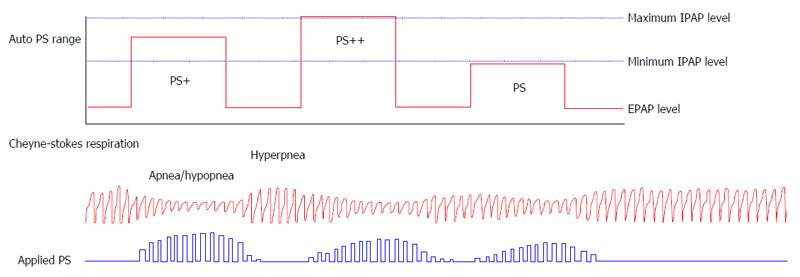Copyright
©2014 Baishideng Publishing Group Inc.
World J Cardiol. Nov 26, 2014; 6(11): 1175-1191
Published online Nov 26, 2014. doi: 10.4330/wjc.v6.i11.1175
Published online Nov 26, 2014. doi: 10.4330/wjc.v6.i11.1175
Figure 7 Adaptive servo-ventilation.
Adaptive servo-ventilation devices automatically provide altering pressure support for each inspiration, ranging from a pre-set minimum level to a pre-set maximum level, to maintain moving target ventilation (determined based on volume or flow) determined by the patient’s current breathing in addition to the back-up ventilation with variable respiratory rates. This stabilizes the abnormal breathing pattern (i.e., cheyne-stokes respiration) and maintains the PaCO2 levels to prevent hypocapnia, which can otherwise trigger apnea reentry cycles. EPAP: Expiratory positive airway pressure; IPAP: inspiratory positive airway pressure; PaCO2: Arterial partial pressure of carbon dioxide; PS: Pressure support.
- Citation: Kato T, Suda S, Kasai T. Positive airway pressure therapy for heart failure. World J Cardiol 2014; 6(11): 1175-1191
- URL: https://www.wjgnet.com/1949-8462/full/v6/i11/1175.htm
- DOI: https://dx.doi.org/10.4330/wjc.v6.i11.1175









